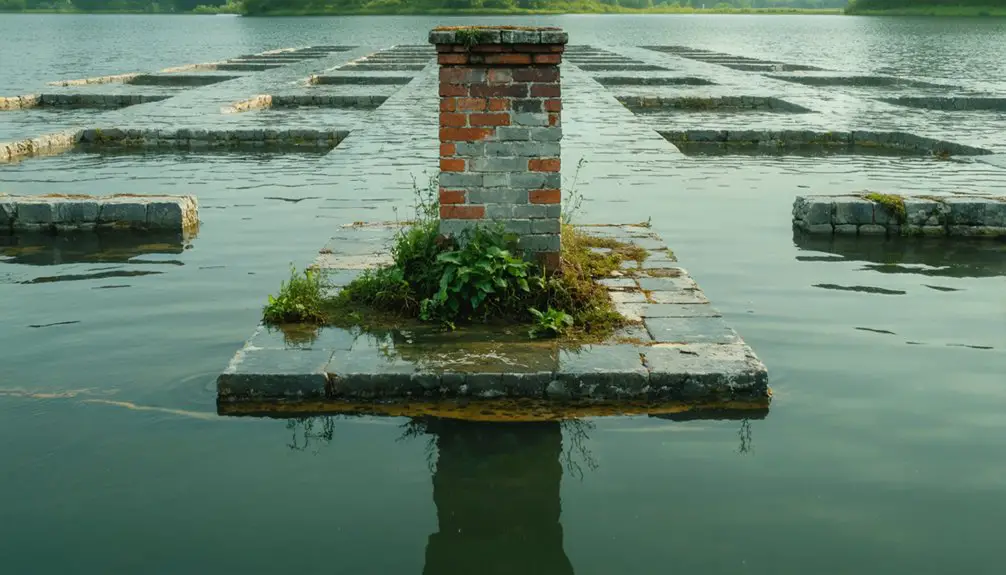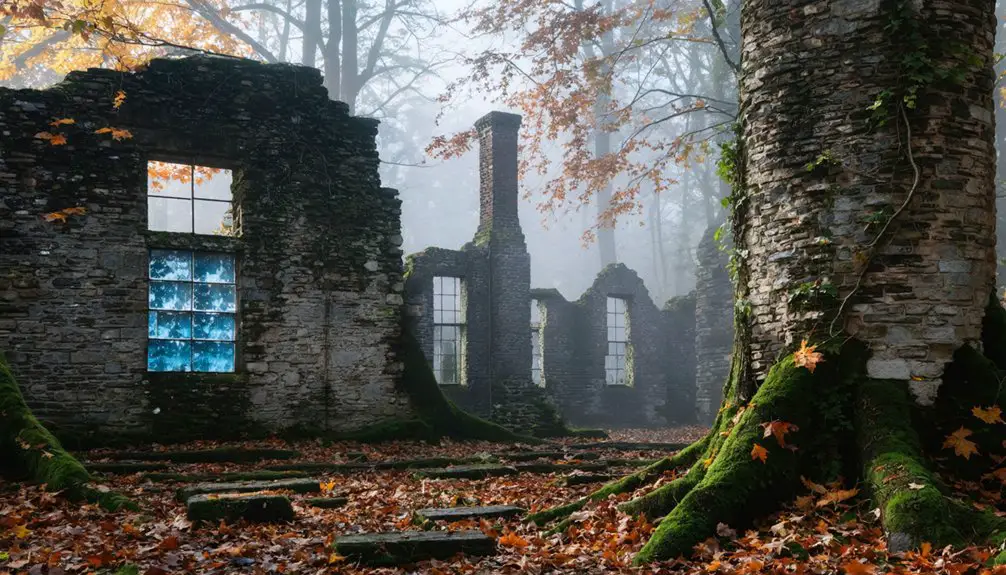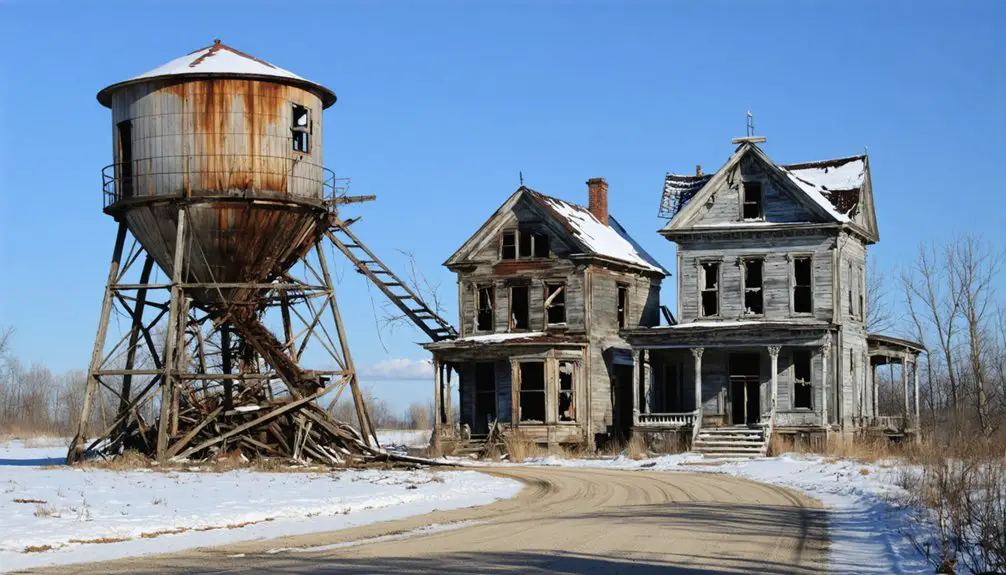You’ll find Dana’s story beneath the waters of Massachusetts’ Quabbin Reservoir, where a thriving rural community of 800 residents once stood. In 1938, the state ordered the town’s evacuation to create Boston’s water supply, marking the end of Dana’s close-knit agricultural lifestyle. Today, you can visit Dana Common when reservoir levels are low, and the Swift River Valley Historical Society preserves the town’s legacy. Dana’s underwater secrets tell a complex tale of progress and sacrifice.
Key Takeaways
- Dana was a thriving rural Massachusetts town that was forcibly evacuated in the 1930s to create the Quabbin Reservoir.
- The town’s final gathering occurred during the Farewell Ball in 1938 before being completely submerged underwater.
- Massachusetts acquired 60,000 acres, displacing residents and relocating 7,500 bodies from local cemeteries for the reservoir project.
- Dana’s remains now lie beneath 150 feet of water, serving as part of Boston’s main drinking water supply system.
- The Dana Common remains accessible during low water periods, with historical markers preserving the town’s memory.
The Last Days of Dana’s Community Life
While Dana had functioned as a close-knit rural community for generations, its final days were marked by the devastating impact of forced evacuation orders from the Massachusetts government.
You’d have found a vibrant town of 33 students attending the Center School, families gathering at the triangular common, and rural traditions deeply rooted in agricultural life. Remnants of these lives can still be seen in the stone walls and foundations that dot the landscape. Community gatherings centered around local farms and businesses, with children often joining the workforce after eighth grade.
The state’s decision to create the Swift River source would provide Boston with essential drinking water but shattered this way of life. As families who’d lived there for generations packed their belongings, they left behind not just their homes but their entire social fabric – a reflection of government power overriding individual rights and community bonds.
Engineering Marvel: Creating the Quabbin Reservoir
Although the loss of Dana was heartbreaking for its residents, the creation of the Quabbin Reservoir stands as one of New England’s greatest engineering achievements.
You’ll find remarkable dam engineering throughout the project, particularly in the massive Winsor Dam and Goodnough Dike, each stretching over 2,000 feet long.
The reservoir construction showcased innovative techniques of its time. Workers used hydraulic fill methods, depositing materials via controlled water streams to build stable slopes. Workers earned 50 to 60 cents per hour during the challenging construction period. Construction began in 1926 and continued through the Great Depression era.
Using water to control material placement, workers pioneered hydraulic fill techniques that created enduring, stable slopes throughout the reservoir.
They employed specialized equipment like drag lines and sheep’s foot rollers to compact millions of cubic yards of soil. A 1,200-foot rock tunnel diverted the Swift River during construction, while 40 reinforced concrete caissons created a crucial cut-off wall.
The result? A masterpiece of water infrastructure that reaches depths of 150 feet and continues serving Greater Boston today.
Displacement and Compensation of Dana’s Residents
The engineering triumph of the Quabbin Reservoir came at an immense human cost. For the residents of Dana, the state’s mandate to solve Boston’s water crisis meant leaving behind generations of family history.
You’ll find displacement narratives marked by both voluntary cooperation and forced removal, as Dana’s town government chose to cede their land while some residents faced eminent domain seizures. A Farewell Ball in 1938 marked the final gathering of displaced residents before their towns disappeared forever.
Questions about compensation fairness lingered as property owners received varying amounts based on their land’s value. The process involved detailed appraisals and negotiations, all documented in records you can still access at the Hampshire Registry of Deeds. The state ultimately acquired 60,000 acres of land to complete the massive water infrastructure project.
Preserving Dana’s Legacy Above the Waters
Despite resting beneath the Quabbin Reservoir’s waters, Dana’s legacy endures through dedicated preservation efforts above ground.
You’ll find historical markers at the carefully maintained Dana Town Common, where stone foundations and walls still stand as silent witnesses to the past. The Swift River Valley Historical Society actively preserves the town’s memories through documents, photographs, and oral histories.
You can explore Dana’s heritage through guided walks, annual events, and educational programs that keep community remembrance alive. The 1938 eminent domain seizure forced over 2,000 residents to abandon their homes forever. The Dugmar Golf Course once operated as a thriving recreational destination in the valley.
The state relocated approximately 7,500 bodies from local cemeteries to protect ancestral connections, while memorial plaques honor former residents.
Digital archives, books, and websites now make Dana’s story accessible to researchers and descendants, ensuring this remarkable piece of Massachusetts history won’t fade into obscurity.
Modern Management and Environmental Impact
Modern stewardship of Dana’s underwater legacy centers on protecting Quabbin Reservoir’s pristine water quality through extensive environmental management.
You’ll find a complex system of monitoring and controls in place, from real-time data collection to active wildlife management, all working to maintain ecological balance in the former Dana region and surrounding watershed.
The reservoir’s natural filtration through surrounding forests eliminates the need for costly treatment facilities, saving Massachusetts ratepayers millions in infrastructure expenses.
Established by Chapter 375 legislation, the reservoir continues to fulfill its original purpose of supplying drinking water to the Boston metropolitan area.
- Continuous monitoring tracks water temperature, turbidity, and potential contaminants
- Forest management plans prevent erosion and maintain natural filtration
- Annual deer hunting programs control populations that threaten forest health
- Active negotiations with landowners reduce pollution from nearby properties
- Strict regulations prevent harmful development, like the proposed Hardwick landfill
These measures guarantee that Dana’s sacrifice continues to serve its purpose, providing clean, unfiltered water while preserving the natural ecosystem that’s evolved since the town’s submergence.
Frequently Asked Questions
What Personal Items Were Residents Allowed to Take During the Relocation?
Though you couldn’t take large safes or structures, relocation policies allowed you to keep your furniture, clothing, household items, garden plants, and memorial items before the town’s demolition.
Are There Any Surviving Buildings From Dana Underwater in the Reservoir?
You won’t find any surviving buildings underwater – they were all dismantled or destroyed before flooding. Despite occasional underwater exploration attempts, no intact structures remain beneath Quabbin’s waters for historical preservation.
How Did Dana’s Residents Maintain Contact With Each Other After Displacement?
Like threads in a cherished quilt, Dana’s residents stayed connected through the Swift River Valley Historical Society, community networks, family gatherings, and letter-writing, providing essential emotional support across their scattered new locations.
What Wildlife Species Emerged in the Area After the Reservoir’s Creation?
You’ll find remarkable wildlife adaptation at Quabbin, where moose, bald eagles, bobcats, and timber rattlesnakes thrive. The reservoir’s protected forests and wetlands support extraordinary species diversity.
Can Scuba Divers Explore the Submerged Ruins of Dana Today?
You can’t explore Dana’s ruins through scuba diving – strict regulations protect Quabbin Reservoir’s drinking water. While you might dream of underwater exploration, all diving activities remain completely prohibited.
References
- https://www.outoftheoffice4good.com/post/hiking-to-the-abandoned-town-of-dana-massachusetts
- https://www.nps.gov/places/dana-common.htm
- https://yourtravelcap.com/abandoned-dana-town-common-and-the-quabbin-reservoir/
- https://en.wikipedia.org/wiki/Quabbin_Reservoir
- https://www.harvardmagazine.com/2023/08/quabbin-reservoir-lost-towns-elena-palladino
- https://www.youtube.com/watch?v=NrBWmYUnqPM
- https://wbsm.com/massachusetts-town-dana-hiking-trail/
- http://www.skinut.net/dana.htm
- https://www.bscesjournal.org/wp-content/uploads/Vol-25_No-3_July-1938.pdf
- http://www.waterworkshistory.us/MA/Boston/1935WaterWorksEngineering.pdf



